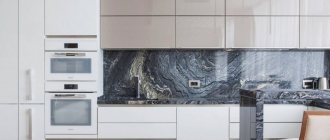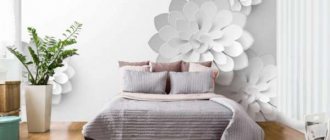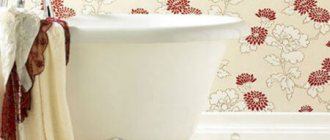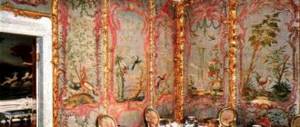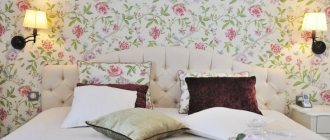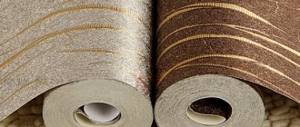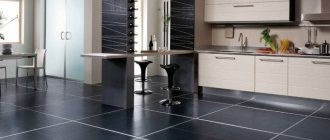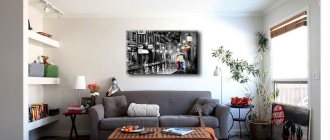The most visited part of any house or apartment is the kitchen. The hostess and keeper of the family hearth spends a lot of time in this room, the whole family gathers here, this is not just a place to eat - it is the hostess’s workplace. Every woman tries to arrange the kitchen as conveniently as possible so that everything she needs is at hand.
In addition to the number and location of cabinets, the interior of the room plays an important role. It should lift your spirits, and in no case cause melancholy and irritation.
Since Soviet times, the only decoration of kitchens has been tiles or tiled panels. This decor is a thing of the past. Today, a popular design solution is beautiful wallpaper in the kitchen interior.
Features and Benefits
- The main advantage of washable wallpaper is its moisture resistance and the ability to clean it with water, a sponge and detergent. Some types of wallpaper are even resistant to brushing;
- Kitchen washable wallpaper is quite durable and, with proper care, will serve you for many years;
- Thanks to the huge selection of colors and textures of washable wallpaper, you can easily choose those that will fit perfectly into your interior and will not hurt your wallet.
Washable wallpaper or moisture resistant?
You need to be very careful when purchasing. Moisture-resistant wallpaper is intended for gluing in rooms with high humidity. But they cannot be washed: they will not withstand mechanical stress. If the wallpaper is moisture resistant, the roll will have a single wave icon.
If the wave is double, triple or one wave with a brush, then this is already washable wallpaper. The more waves, the less susceptible they are to mechanical stress. Brush means they can be rubbed vigorously with rags, brushes and sponges. Detergents can be used on all wallpapers, except those with two waves.
Varieties
- Paper . Since paper is not a moisture-resistant coating, such wallpaper is rarely used for kitchen decoration. The only acceptable option may be wallpaper made from several layers of paintable paper - in this case, it is necessary to select a special paint that can withstand wet processing;
- Acrylic . Wallpaper on a paper basis, with a polymer coating applied to the surface. The fabric is quite dense, with a velvety top layer, which has sufficient wear and moisture resistance. It is only recommended not to use detergents or brushes with synthetic bristles when cleaning them;
- Vinyl . Their base is made of paper or fabric, with a layer of polyvinyl chloride applied on top. These wallpapers are highly durable and moisture resistant; some types are even used in bathroom decoration. They are not susceptible to fading due to frequent washing or exposure to direct sunlight. These wallpapers are called super washable, because... when cleaning them, you can use almost any detergent and even hard sponges and brushes;
- Non-woven . They are a type of vinyl wallpaper. For their production, a non-woven fabric made from a mixture of cellulose and mineral fiber, called non-woven fabric, is used. Such wallpaper does not deform when hung, improves sound insulation, and can also withstand up to 15 paintings. It is recommended to paint with water-based, acrylic or latex paint;
- Fiberglass or so-called “matting”. Very beautiful, highly durable washable wallpaper. The components used in their production: dolomite, soda, quartz sand, lime - are environmentally friendly. This wallpaper is famous for its moisture and heat resistance; it does not show scratches or holes; they are very easy to glue. Very resistant to detergents containing acids and alkalis. When painting, the texture is preserved;
- Metallized . Modern, very unusual washable wallpaper. They consist of a paper or fabric base and thin aluminum foil with an embossed pattern applied to its surface. Such wallpaper looks very aristocratic and expensive; it tolerates washing well with any detergent. However, it should be remembered that they are airtight; accordingly, the room covered with such wallpaper must be frequently and thoroughly ventilated;
- Liquid . This wallpaper differs from others in that it is made in the form of a dry mixture, which must be diluted with water and then covered with it on the walls. To ensure that they can be washed after drying, a layer of acrylic varnish is applied to protect the coating;
- Cork . They are made from pressed cork. Cover the walls with sheets and then cover them with varnish. Such wallpaper retains its original appearance for a long time, is easy to clean and lasts a long time;
- Self-adhesive plastic wallpaper. Their peculiarity is the presence of a sticky base (fabric or paper), on which a layer of polymer coating is applied. For the kitchen, plastic wallpaper with an embossed pattern for painting is most often used.
Types of washable wallpaper
- Acrylic have a paper base. A thin layer of foamed acrylic is applied to it, which forms a moisture-resistant surface on the surface.
These wallpapers have a three-dimensional pattern that presses out when pressed. The surface of acrylic wallpaper can be wiped with a damp sponge, but under no circumstances should it be rubbed. Prolonged contact with moisture is also detrimental to them.
- Vinyl washable wallpaper is a base made of paper, fabric or non-woven material, covered with a layer of polyvinyl chloride, which can be foamed or smooth. In any case, the vinyl surface of such wallpaper is durable and wear-resistant; it can be washed using household chemicals and even cleaned with a brush. There is also a type of wallpaper that is made specifically for the kitchen; its surface is especially durable.
- Non-woven wallpaper is made on the basis of non-woven material from textile or cellulose fibers connected by a polymer, which makes the non-woven material moisture resistant. This coating can be easily cleaned with a damp soft cloth.
Such wallpaper can be covered with one or two layers of non-woven material, and often has a structured surface that can be coated with waterproof paint.
- Glass wallpaper - a relatively young finishing material. Essentially they are fabric woven from fiberglass threads.
They have a number of advantages - thanks to their density and thickness, they can smooth out small unevenness on the walls, mask cracks and other flaws. Glass wallpaper can be repainted, and they also have good moisture resistance - they can be cleaned and washed.
- Liquid Wallpaper has an original form of delivery - in the form of a powder, which consists of cellulose, dyes, and mineral additives. This wallpaper is applied to the walls with a roller and diluted with water before use.
Moisture resistance is ensured using a protective acrylic varnish that covers the liquid wallpaper. Then such a surface can be wiped with a damp sponge, and if it is heavily soiled, it will not be difficult to remove part of the surface and apply a new layer.
- Metallic wallpaper has a paper base, on which thin foil and a layer of non-conductive paint are applied. The surface of metal wallpaper is wear-resistant and not afraid of moisture - they can be washed without fear of spoiling it. But there are also disadvantages - to glue them you need a perfectly flat surface. The wallpaper itself is airtight, which is why it can absorb odors, so the room will have to be ventilated periodically. The price of metal wallpaper is high.
- Cork with wax coating - an original material made from oak cork with a thin wax coating, which ensures good moisture resistance - they can be wiped with a damp sponge.
A room with walls covered with such wallpaper has good sound insulation, but there is also a significant drawback - the high price of cork wallpaper.
Decor and colors in the interior
In modern construction stores, the choice of types and colors of washable wallpaper makes your eyes wide open! Whatever your interior is - simple or designer-refined - you can always choose the necessary pattern and texture of washable wallpaper to match it.
When choosing wallpaper colors for your kitchen, consider the following recommendations:
- You should not overload the interior with various textures and variegated colors - place accents. If you want to focus attention on interesting wallpaper, then choose furniture that is neutral in color and without unnecessary decorations; if your kitchen set is designed to attract all attention to itself, use plain wallpaper to create a neutral background;
- Do not mix shades of warm and cold colors in the interior. When choosing a harmonious combination of colors, you should pay attention to where the windows of your kitchen face. If they are directed to the north or west, warm shades are preferred - cream, beige, yellow, orange. If you are facing south or east, choose shades of the cold spectrum: silver, blue, green;
- There are a lot of special “kitchen” patterns for washable wallpaper - there are wallpapers with patterns of food, drinks, fruits and vegetables, as well as with patterns of teapots, mugs, spoons and forks. You can choose this color for the wallpaper if your kitchen is not decorated in any special style, but is simply a place for cooking and is decorated with potholders hanging on the walls, sets of frying pans or bright mugs and plates;
- To change the visual space of the kitchen, choose striped wallpaper. Vertical will lengthen the walls, horizontal will expand them. Small stripes are preferred;
- If you have decorated your kitchen in a rustic style - you have installed furniture made of solid wood, and use clay trinkets and dishes for decoration - then you can hang wallpaper with a “brick” or “natural stone” pattern. This combination will be very successful; it will create the effect of rough masonry walls and a certain touch of rustic chic.
7 photos
How to choose
When choosing washable wallpaper for the kitchen, follow these recommendations:
- Look at the roll label. It should contain information about the technical and operational features of the selected model. It is best to choose wallpaper with increased moisture and light resistance, vapor-tight and with a high coating density;
- It is advisable not to buy wallpaper with a convex pattern - dirt will accumulate in the relief and it will be quite difficult to remove it from there;
- Distinguish between waterproof and washable wallpaper - the former cannot be washed! For kitchen walls, choose only those types of wallpaper that can be washed with water and cleaning products;
- Wallpaper must be resistant to the absorption of various odors.
7 photos
How to wash wallpaper correctly
There are many cleaning solutions that are designed for regular wet cleaning of wallpaper. Some of them are inexpensive, but they are as effective as expensive detergents.
As an economical detergent, you can use a soda solution. When using it, it is important to remember that it should not be used too often.
Any surfaces that are washed should be done carefully. With very thorough cleaning there is always a risk of damage to the top layer of wallpaper.
Wallpaper cleaners:
- Soda solution;
- Soap solution;
- Strong chemical solutions.
When choosing a product, it is important to consider the type of wallpaper. When purchasing, you need to carefully study the instructions for use.
General recommendations:
- Prepare cleaning solution according to instructions.
- Test a piece of wallpaper in an inconspicuous place.
- Remove dirt using smooth movements. Wipe the surface dry.
For wallpaper to have a beautiful appearance, it must be washed regularly and carefully. For daily care, wet wiping using plain water is suitable.
How to glue
- Be sure to prepare the walls using a primer - the smoother they are, the easier it will be to hang the wallpaper beautifully and efficiently;
- Wallpapering starts from the window;
- Thick wallpaper is glued only end-to-end; ideally, the seam should be almost invisible;
- It is very important to choose the right glue - for washable wallpaper, only a reliable, high-quality composition intended for heavy canvases is suitable.
Care
From time to time, kitchen walls need to be washed to remove accumulated grease, soot, dust, and food stains. Here are a few tricks for caring for washable wallpaper:
- Before completely washing the kitchen walls, you need to check the effect of the selected detergent on the wallpaper. To do this, apply the product to a small, inconspicuous area of the wall and wait until it dries completely. If the wallpaper has not changed color and texture, proceed to cleaning the entire surface;
- You can wash different types of wallpaper in different ways: it is recommended to only wipe thinner paper-based wallpaper with a soft cloth using a small amount of water; while thicker wallpaper can be treated with various detergents using a sponge, and in some cases, a brush. Be thoroughly familiar with the care features for your wallpaper so that it lasts a long time and does not deteriorate;
- If you have wallpaper with a three-dimensional pattern in your kitchen, you should thoroughly wash all the dirt and dust that has settled in the relief. Use a small sponge and detergent for this. Afterwards, rinse the drawing thoroughly with clean water;
- You shouldn’t wash even heavy-duty wallpaper too often - do it when it gets dirty. Remember that any mechanical impact in one way or another reduces the service life of your wallpaper.
Using wallpaper
Installation technology
Materials for work
As we noted earlier, gluing such trellises with your own hands is quite simple.
The technology in this case is as follows:
- We clean the walls from the old finish, scraping it off with a spatula or a sander attachment.
- Then we level the surfaces using putty. Differences in the plane of more than 5 mm should either be plastered or sheathed with plasterboard.
- To ensure the most effective adhesion and reduce glue consumption, we treat the putty layer with a penetrating primer.
Note! It is advisable to purchase primers with antiseptic components, since they are the ones that most effectively protect the wall from fungal attack.
- Next, cut off strips of the required length from the roll (be sure to leave a margin to match the pattern).
- Apply the adhesive mixture to the wall, then apply wallpaper to it and level it using a plastic spatula. The glue must be chosen in accordance with the type of material, otherwise there is a high risk that over time the finish will begin to fall off.
Gluing trellises to the wall
- To ensure that the canvas sticks as tightly as possible, we roll it with a special roller.
- We glue the next strips end-to-end, making sure that the material does not stretch across the width: after drying, this can lead to the formation of gaps between the wallpaper.
Care Tips
Despite the fact that the material is called “washable,” it should still be handled with some caution.
The instructions recommend care as follows:
- Before starting wet cleaning, treat the walls with a vacuum cleaner or wipe with a dry cloth. This will allow us to remove a significant amount of dust, which could otherwise form unsightly, difficult-to-remove stains.
- To wash walls, you should use a soft sponge or a brush with natural bristles. The use of too rigid products can lead to damage to the protective layer and the waterproofness of the material will be compromised.
For care, use a soap solution and a soft washcloth.
- It is best to wash wallpaper with a mild soap solution. Instead of soap in the kitchen, you can use a solution of dish soap with an anti-greasy effect: this way we can remove dirt without unnecessarily strong effects.
Note! Before applying the solution to the wall, you should wring out the sponge: it should be damp, not wet. The same applies to the brush - before processing, you should shake off the largest drops from it.
- It is necessary to carry out wet cleaning, and especially treatment with detergents, as rarely as possible. Otherwise, after a couple of years, the wallpaper will look untidy due to the damaged outer layer and faded shades.
How much are
The cost of washable wallpaper for the kitchen depends on many factors, ranging from materials of manufacture and ending with the manufacturer. The cheapest washable wallpaper is paper wallpaper with water-repellent impregnation. Their price is very low - about 90 rubles per roll, but it must be remembered that their service life is also short (about 3 years). Next on the list are paper wallpapers containing vinyl - their cost varies from 120 to 500 rubles per roll. Thick vinyl and non-woven wallpapers are more expensive - from 400 rubles per roll, but they will last longer. The price of beautiful metallic wallpaper reaches several thousand per roll.
The manufacturer is also important. Domestic and Ukrainian-made “Slavic” wallpapers are an order of magnitude lower than European-made wallpapers.
Interesting solutions in the interior
Well-chosen washable wallpaper can be a wonderful addition to the interior of your kitchen, making it bright and original. Previously, we looked at several types of wallpaper and rules for selecting colors depending on the kitchen design. There is another very interesting type of washable wallpaper for the kitchen, which will definitely add zest to any interior - photo wallpaper.
It is better to take vinyl or non-woven wallpaper for washable photo wallpapers for the kitchen, as there will be a need to wash them from various contaminants. It is best to place them on a wall away from the cooking area. The theme of the image on the photo wallpaper should be in harmony with the overall style of the kitchen design:
- When decorating a kitchen in a classic or country style, choose photo wallpapers with rustic motifs, still lifes, and landscapes. The “apron” of the kitchen can be finished with photo wallpaper that imitates a coating made from natural materials: brick or stone masonry, wood, cork, bamboo;
- An extraordinary and very interesting high-tech style involves unusual three-dimensional images on photo wallpapers - abstract figures, paintings in the surrealism style, cosmic and urban elements.
Photo wallpapers often become the main accent in the interior, so it is best to place them where the entire picture will be visible in its entirety, and not cluttered with furniture or household appliances.
A small kitchen will be decorated with photo wallpapers that occupy the entire wall - this technique will visually expand the boundaries of the room and give it volume. But in a large kitchen, you can experiment with the arrangement of canvases in the same color scheme and theme, symmetrically to each other - one of them will be in the cooking area, the other in the eating area. You can also cover parts of the kitchen furniture or the door with photo wallpaper. In general, don’t be afraid to imagine, experiment and arrange your kitchen according to your taste and wishes.
